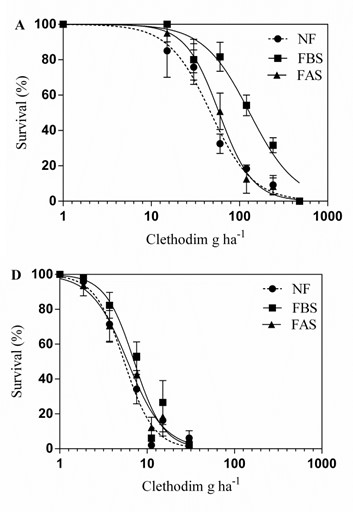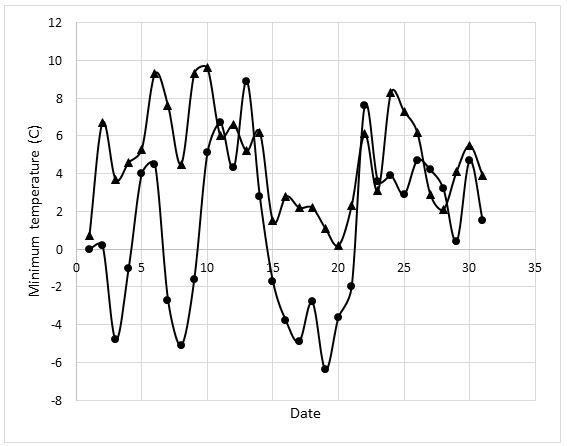How can I best control herbicide resistant annual ryegrass in canola crops
Author: Gurjeet Gill, Peter Boutsalis and Chris Preston (School of Agriculture, Food & Wine, University of Adelaide). | Date: 21 Jul 2016
ɸExtra technical comment by Protech Consulting Pty Ltd
Background
Herbicide resistant annual ryegrass populations can be found throughout the cropping regions of Australia. For example, in a recent survey of the mid-north region of South Australia (SA) we found 79 per cent of the populations to have resistance to aryloxyphenoxy propionate (FOP) herbicides. In contrast, clethodim resistance was confirmed in 13 per cent of these ryegrass populations from the mid-north of SA. Fortunately, many of these FOP resistant ryegrass populations can still be controlled with the application of clethodim even though it is also a Group A herbicide. Research in SA and WA has confirmed that many target-site mutations give a high level of resistance to FOP herbicides, but clethodim can still provide effective weed control. However, best results for clethodim on such populations are likely to be achieved by:
- Spraying small ryegrass plants (before tillering starts).
- Spraying earlier in the season when conditions are warmer.
- Not spraying ryegrass plants affected by frost or if the frost is imminent over the next 2-3 days.
Clethodim rate and mixture with butroxydim (Factor)
In most cropping areas, clethodim rates have gradually increased as ryegrass populations evolved resistance to group A herbicides. Clethodim at 150-250mL/haɸa used to provide excellent control of ryegrass for several years after its release in Australia. Most growers are now using clethodim at 500mL/haɸb to control ryegrass in their pulse crops but canola tends to be more sensitive to clethodim so it is not advisable to use this high rate.
ɸaRecommended rate when using a product that contains 240g/L active. ɸb500 mL/ha is above label rate when using a product that contains 240g/L active but is within label recommendations when using a product that contains 120g/L active. It is important that you read the label carefully and only apply product that follows label recommendations.
Butroxydim (Factor) is another cyclohexanedione (DIM) herbicide, which can improve ryegrass control when used in mixture with clethodim. This mixture is now commonly used for ryegrass control in pulse crops to achieve improved weed control as compared to clethodim alone. Unfortunately, canola is more sensitive to butroxydim than legume crops and there are warnings on the label about the need for caution when using this herbicide in canola.
Clethodim and frost events
Growers are reporting variable control of annual ryegrass with clethodim. Poor performance of clethodim can be associated with cold and frosty conditions. We undertook trials in 2013 and 2014 to examine the effect of frost on clethodim efficacy on annual ryegrass. These trials were conducted under controlled conditions in a frost chamber to mimic a frost event. Seedlings at the three leaf stage were sprayed with increasing rates of clethodim at midday, either before or after exposure to three consecutive nights of a -2 oC frost treatment.

Figure 1: Control of annual ryegrass populations with low level clethodim resistance (A) can be significantly reduced by exposure to frost before the spray. In contrast, the control of susceptible ryegrass populations (B) showed relatively small response to frost. Label rate of 250mL/ha = 60 g ai/ha. NF = no frost, FBS = frost before spraying, FAS = frost after spraying.
Frost treatment, particularly before clethodim application, reduced clethodim activity in susceptible annual ryegrass populations. Clethodim efficacy was further reduced in resistant annual ryegrass populations regardless of whether the frost event was prior to or post clethodim application. However, the impact was much greater when frost occurred before clethodim application (Figures 1A & B). Frosty conditions make it even harder to control annual ryegrass when clethodim resistance is present in the population.
Considering these findings and several other field observations by agronomists and researchers, growers are advised to carefully review weather forecast for their district and spray clethodim when cloud cover is present and the risk of frost occurrence is low. Ideally spray small ryegrass plants under warmer and frost-free periods for the best results with clethodim on ryegrass.
Many cropping areas of Tasmania are likely to be colder than the milder Mediterranean climate of South Australia. In the example below, daily minimum temperature of July 2015 for Cressy Research Station near Campbell Town (TAS) has been compared with the temperature for the same period at Roseworthy (SA). Many canola crops are likely to be sprayed for ryegrass control during July. There were 14 days (nights) with minimum temperature below 0oC at Cressy as compared to zero days for Roseworthy. Clearly stress imposed by frost is likely to be a highly significant factor affecting clethodim efficacy on annual ryegrass in Tasmania.

Figure 2: Comparison of daily minimum temperature in July 2015 at the Cressy Research Station near Campbell Town (Circle), TAS and Roseworthy (Triangle), SA. Note there were 14 sub-zero days at Cressy as compared to zero at Roseworthy, SA.
Canola competition can improve clethodim performance
There is large variation in early vigour and weed suppressive ability of canola varieties currently available to Australian growers. Hybrid varieties (e.g. Hyola types) tend to be larger seeded and have much greater early vigour especially in comparison with triazine tolerant varieties. As clethodim tends to kill a large proportion of ryegrass plants in most weed populations and often suppresses the growth of resistant plants, its combination with hybrid canola varieties can result in a large reduction in ryegrass growth and seed production.
In order to extend the effective life of clethodim, it is important to maintain ryegrass populations at a low level by integrating pre-emergence herbicides and other tactics such as crop-topping and use of narrow windrow burning or harvest seed collection or harvest seed destructor.
Conclusion
Clethodim resistance has been increasing in the southern region at a steady rate to a level of 10-15 per cent of ryegrass populations. In most cases, clethodim still provides fairly good ryegrass control provided weeds are sprayed early (small size and warmer weather) and at a time when frost is unlikely to occur 2-3 days before or after clethodim spray. Canola varieties differ markedly in their ability to compete with weeds. Use of weed suppressive hybrid canola can considerably boost clethodim efficacy on ryegrass.
Acknowledgements
The authors would like to thank the GRDC for supporting this research.
Contact details
Gurjeet Gill
School of Agriculture, Food & Wine, University of Adelaide
(08) 8313 7744
gurjeet.gill@adelaide.edu.au
GRDC Project Code: UA00159,
Was this page helpful?
YOUR FEEDBACK
